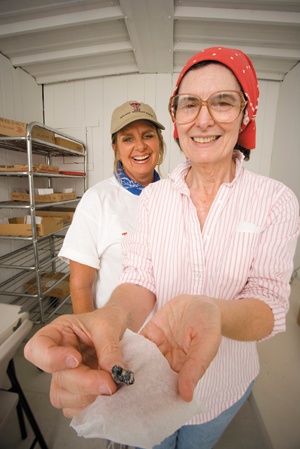Covered by a tarp that flutters under a hot July sun, a half-dozen men and women, most of them graduate and undergraduate students at Texas Tech University, huddle in a cavity of West Texas earth that was once an ancient watering hole. In pairs or singly, the students scrape small areas of dirt, each about a square meter and separated by string. One woman’s careful brushstrokes reveal tortoise leg bones.
Roland Springs Ranch, located in Scurry County and owned by Big Country Electric Cooperative members Robert and Tina Roland, hosts a zoo of potentially 400,000-year-old animal bones, including remains of coyotes, small horses, birds, fish, frogs, lizards and toads. The couple’s first inkling they’d found something special was a large tortoise shell uncovered by erosion and helped along by their own pocketknives and pens. “We stabbed and jabbed at first,” before calling in an expert, Tina says.
According to Dr. Eileen Johnson, director of the Lubbock Lake Landmark, a unit of the Museum of Texas Tech University, the numerous Roland Springs findings, which she tentatively places in the Middle Pleistocene epoch, are significant.
“It’s very rare,” Johnson says. “There are only a handful of these published finds across the country.”
Tina directs members of the crew to doughnuts under a mess tent and welcomes a neighboring family who stops by, joining them to admire the large cat tooth Johnson displays. Tina hopes it’s from a saber-toothed tiger, but Johnson says it’s too soon to tell. For Tina, the excitement of this four-week dig outweighs any inconvenience.
“It’s really just a small part of the ranch,” Tina says, pointing to the 5-by-8-foot plot. “And how can it be an intrusion when it has so many benefits?”
The enjoyment and education are two of the main advantages, she says. Tina and Robert plan to donate the findings to the Museum of Texas Tech University, with replicas going to the Scurry County Museum, so others can enjoy and learn from them.
Riverbank Yields a Layered Village
In 1995, Frank Sprague retired as a wildlife biologist and looked forward to spending time with his wife, Evelyn, on their land north of Hamilton. “I always had a historical interest in the area,” Frank said. He expected to find arrowheads from the past few hundred years or so, but erosion along the banks of the Leon River soon exposed far older surprises: burnt rock from cooking fires and ancient tools used thousands of years ago.
The Spragues enlisted help from experts at the Texas Historical Commission who sent several stewards, volunteer archeologists trained in field techniques and members of the Tarrant County Archeological Society. Their findings along the riverbank included abundant mussel shells, charcoal, scrapers and knives, all indicating early villages along the river. Ancient, earthen ovens were also found eroding from the bank, along with a pair of hand-sized grinding stones, or “manos.” Archeologists determined that the findings went deep, at least 12 feet below the modern surface.
“There were several levels of occupation,” says Sprague, who is a member of Hamilton County Electric Cooperative. “One group would leave their stone tools, and another group would come in.”
The Spragues have loaned some items for display in the local museum; they will retain ownership of the artifacts, a choice all landowners have, Frank explains. The age of the artifacts spans thousands of years. Charcoal samples have yielded two dates: 800 B.C. and 2,000 B.C. Animal bones retrieved from the site help determine what was available for ancient peoples to eat.
“There were mussels and fish, buffalo and antelope, and pecan and oak trees,” Sprague said. “They had many resources here; it was a good place to be.”
The Spragues enjoyed working with the Texas Historical Commission’s archeological stewards so much that Frank became an active member of the Hamilton County Historical Commission and a steward in 2001. He encourages other landowners to get involved.
If you find you have a real interest in the preservation of our past, check into the Texas Archeological Society, www.txarch.org. The semiannual publication Current Archeology in Texas (a free publication) is accessible on the Texas Historic Commission website, www.thc.state.tx.us, or contact the magazine at (512) 463-6096.

